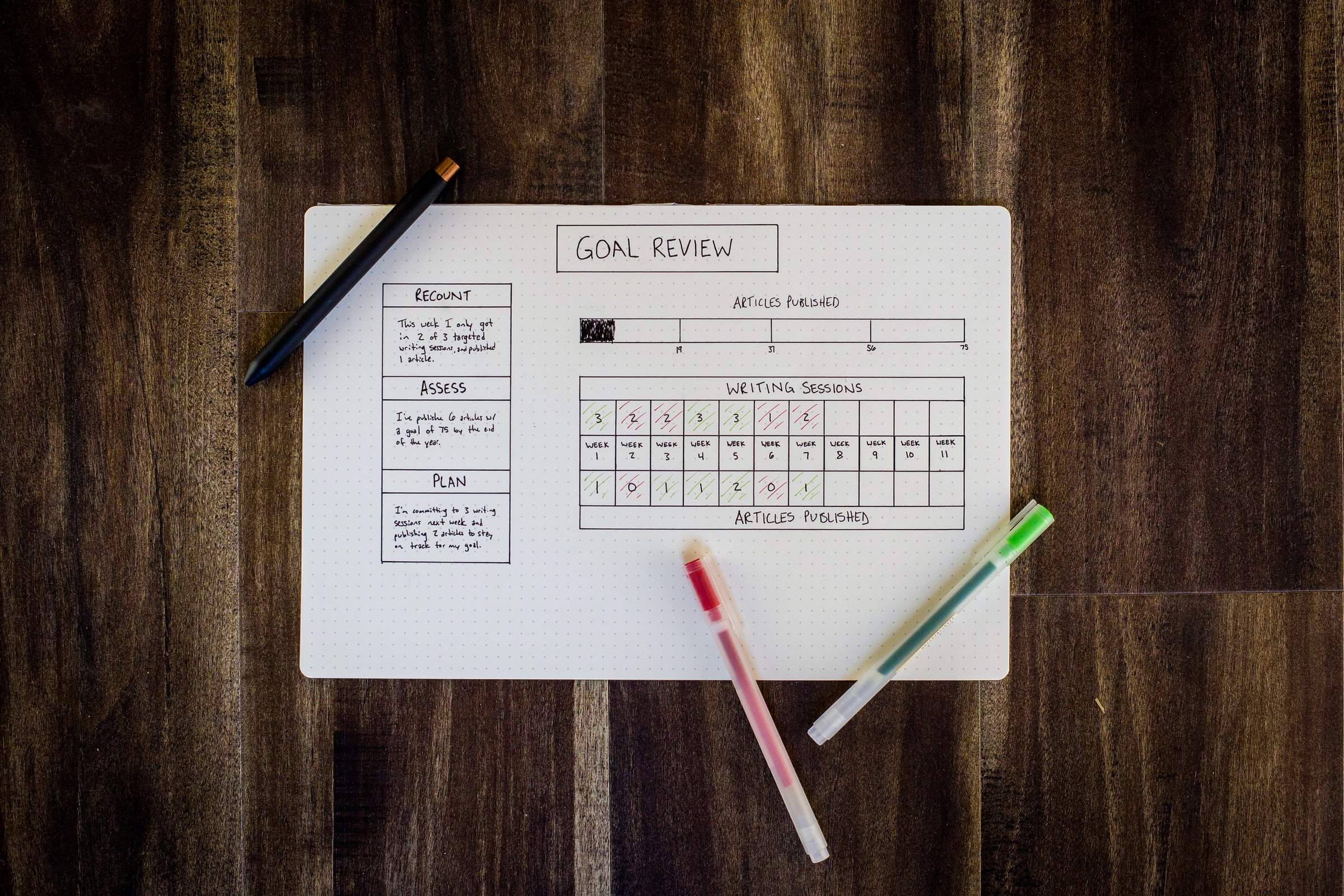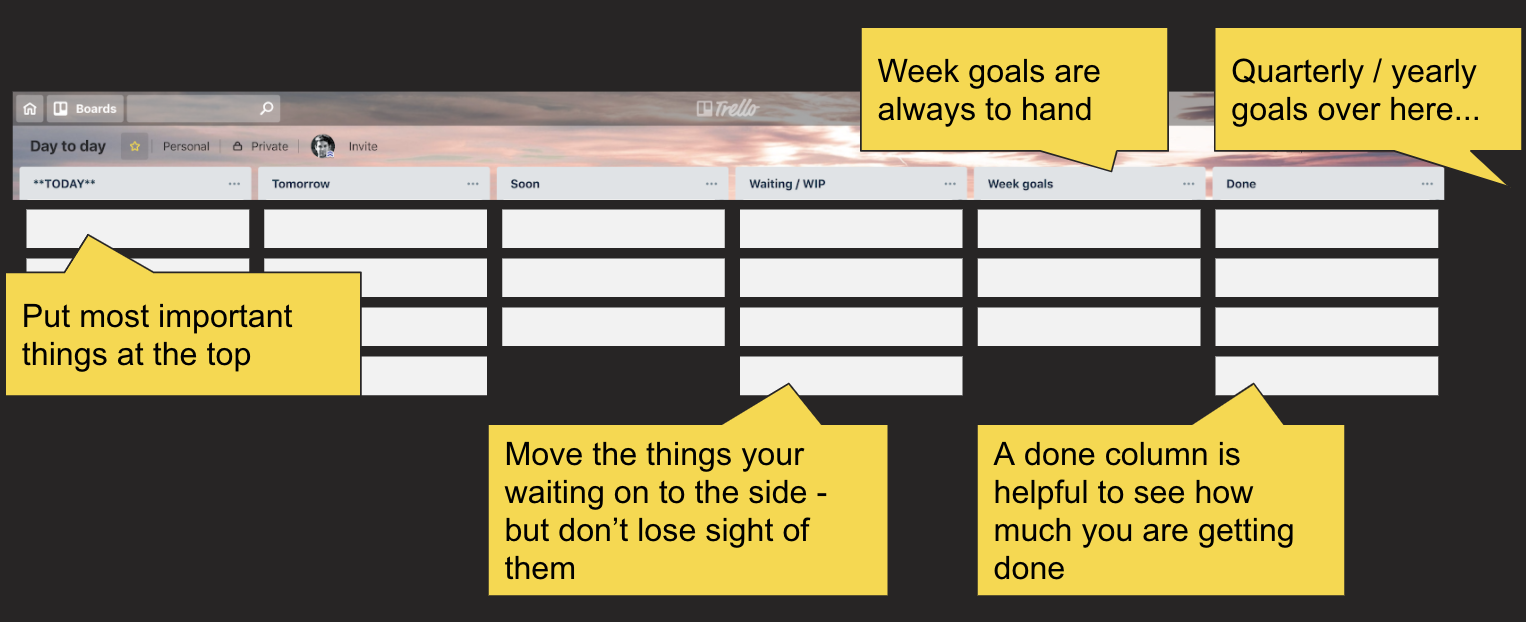Don’t you wish that there were a few more hours in a day, so that you were able to get more things done? Us too. Unfortunately, none of us can control time–none of us except for Hermione Granger.
What we can control, however, is how we manage the time we have.
If you want to get things done, you need to be cautious of how you spend your time–you need to actively plan for productivity. It’s a habit-building exercise, which means it will take time–anywhere from 18 to 254 days, in fact.
Needless to say, it will take time to learn good time management skills–it’s a marathon, not a sprint. Luckily, we’re here to help you run the race.
In this blog post, we will be taking a look at how you can get things done in an efficient manner using personal tips from our Co-founder and CEO, Chris Finneral. So get ready…. set… go!
Ensure that your mission and goals are clear
Before you can be productive both at work and in your personal life, you need to know what you’re working towards. Set aside time for self-reflection and ask yourself: what is your mission not just at work, but in life? Clarity on these topics is needed first, as it determines what comes next: goals.
Write out your mission and from there, translate it into big/long-term goals which then break down into smaller/short-term goals. Getting these thoughts onto paper (or into your computer, whatever works best for you!) helps make each idea more tangible.
Once you have all of these mapped out, go a step further and categorize your goals into:
- Daily
- Weekly
- Quarterly
- Yearly
A timeline helps not only prioritize what needs to be done in the immediate time frame compared to what can wait until later/be an ongoing project, but helps you keep yourself accountable too.
Overall, mapping out your mission and goals:
- Provides direction
- Helps you focus on what’s really important
- Speeds up the decision-making process
- Alleviates stress
- Boosts your confidence
- Provides motivation
- Gives you a sense of purpose and personal satisfaction
Review your goals daily
Writing down your missions and goals is just the start, though. If you note down your mission and goals on a piece of paper only to stuff it in a drawer and never see them again, you might as well not have written anything down at all.
In order for the first exercise to be effective, you must create a habit of reviewing your goals daily. Keeping your goals at the forefront of your day-to-day routine is the way to make them happen.
Daily, weekly, quarterly & yearly reviews
Small goals: At the start of each day, review your goals for 15 minutes–then proceed to plan your day accordingly. At the end of each week, set aside about an hour to review your goals.
Big goals: Review your quarterly goals for half a day at the end of each quarter. For annual goals, increase this to an entire day at the end of each year–one dedicated to reviewing your mission and goals as a whole.

Look back and forward during reviews
When conducting these reviews, it is also essential that you look both backwards and forwards.
First, look backwards: review your accomplishments and misses, evaluating the contributing factors for each. Analyze your overall impact–you can both celebrate the wins and reflect how the losses could’ve been avoided.
Then, look forwards: based on what you’ve learned, clear out the “junk”–unnecessary goals, practices and more. Move forward by setting clear and prioritized goals based on past performance and discoveries. Finally, communicate changes as needed, whether it be to your manager, team or family.
Capture new goals in real-time
In addition to focusing on your existing goals, it’s vital to capture new goals in real-time. This includes, but is not limited to:
- New requests from colleagues and/or clients
- Things you verbally committed to
- New ideas
- Preparation for meetings
If you need a tool for your goals arsenal, check out Trello. An agile Kanban board that is visual and flexible (not to mention free!), Trello can help you not only keep a track of the minute details, but paint the bigger picture as well.
In Trello, you can create columns for your daily, weekly, quarterly and yearly goals to keep a track of them in an efficient manner. Creating a “done” column to note down how many projects you’re completing is also encouraged, as it not only helps you track what is getting accomplished but can also help boost your confidence throughout the process.
With this being said, we realize there will always be some tasks for which you have to wait on certain things/other people in order to consider “done”. When this happens, move them to a different column specifically created for this purpose (“Waiting”/”Work In Progress”) so you can be sure to not lose sight of them.
A final note: for all columns, be sure that you are noting down the most important things at the top. Just like you wouldn’t put a bill you needed to pay at the bottom of your mail pile, so too should you not visually deprioritize the most important goals.

Work smart and start with the most important things
If you want to get things done, you need to not just work hard, but work smart. That doesn’t mean working less–instead, it means working on things that truly matter.
With your goals in mind, eliminate the unnecessary and not-so-important tasks and focus on what has the biggest impact.
80-20 and iterative execution
Ever heard of the 80-20 rule? Also known as the Pareto Principle, this rule states that about 80% of your outcomes (outputs) result from 20% of the work put in (inputs). As such, it’s important to identify your best work to create maximum value.
Iterative execution is a tool that helps us move towards finishing that 20%–it’s all about meeting the end goal through a repeated cycle of operations. Many of us have the tendency to delay when faced with a large/important question or problem, thinking we must pour all of our effort into finding the entirety of the answer or solution before moving forward. We like to call this “paralysis by overanalysis.”
Next time you feel yourself beginning to succumb to this phenomenon, do this instead:
- Note your immediate thoughts and/or answer quickly
- Get feedback
- Iterate until completion (until the end-result is perfect)
Protect your productive time
While we likely all wish we could be productive 24 hours of the day, unfortunately it doesn’t work that way. As humans, we experience periods of high energy and low energy, as well as creativity valleys and peaks. For a lot of us, though, there are at least semi-predictable trends.
Ask yourself: at what time of the day am I the most productive? When am I least productive?
If you are the most productive between noon and 4 pm, for example, protect this time. During this period, you should avoid meetings, commutes, phone notifications, and more if possible. Calendar blocks can be a huge assist in making this happen, allowing your colleagues to see that you’re busy and barring them from booking meetings with you during this time.
Create a Zen workplace
If you want to be productive during the time that is most conducive for you, you need to surround yourself with the right things–or perhaps more accurately, don’t surround yourself with distractions.

Here are a few ideas on how to make your workplace a prime spot for productivity:
Physical
- Clean your workplace so it is free of distracting clutter
- Have a big cup/bottle of water at the ready, so that you have to get up less
- Go to a quiet place and/or use headphones (you can listen to music, just depends on how you work best!)
- Steer clear of unnecessary conversation, etc.
Digital
- Switch off your notifications, leaving on only the ones you really need such as calendar notifications or direct slack mentions
- Separate browser windows (avoid hundreds of tabs)
- Clean your desktop by dragging everything into a junk folder
Build grit & determination
Want to know the secret behind the success of others? Hint: it’s not that they are more talented than everyone else. Instead, the reason why they are so successful is that they are passionate about their goals and work to achieve them no matter what. In summary, they possess grit and determination.
There will be times where you thrive, and times where you fail–failure is simply a part of life. However, you cannot let the failure deter you–instead, let it fuel the fire. Keep moving, be consistent and work towards achieving your goals.
Lead a healthy life
An August 2017 study found that companies offering employee wellness programs saw a significant gain in productivity among workers: an average of one full workday per month.
As the study illustrated, health is inextricably tied to your productivity levels. This means that in order to work efficiently, your body and brain need the right fuel.
Here are a few ways you can take care of your body and brain:
- Exercise regularly
- Eat a balanced diet
- Sleep 7-9 hours per night
- Stay hydrated
- Take breaks for fun and family time
Leading a healthy life will help you bring out the best in you, boosting your productivity.
Be kind to yourself
None of us will get these practices right every day–we’re only human, after all. Don’t be too hard on yourself if you forget to check your goals one day, eat junk food the following day, and lose some of your productive time another.
Just remember: like everything in life, it’s a learning process. Whenever you make a mistake, acknowledge it and use the lesson learned to do better next time.
Start today and never stop
We realize there’s a lot of action items above, which can feel daunting. Don’t let fear of failure stop you from getting started–simply start with your mission and goals and iterate from there.
If this is new to you, it will take time to develop your habits–you will need to think about it consciously, dedicate time to the practice itself and stay open-minded regarding areas of improvement. (Chris himself still finds ways to improve after years of practice!) But rest assured that if you stick to it, you will be rewarded. With better time management, you can achieve more, do so in less time, and be more fulfilled both in your career and personal life.
So what are you waiting for? Off to the races!
